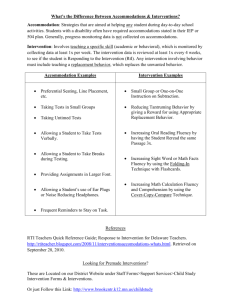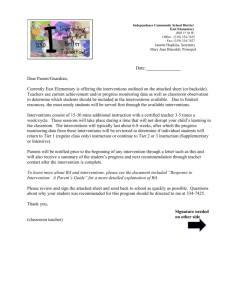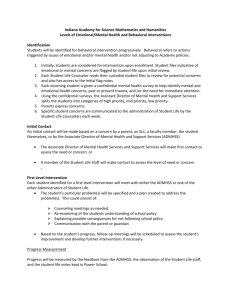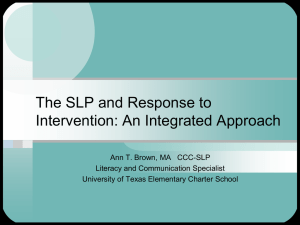Applying behavioral principles to increase the
advertisement
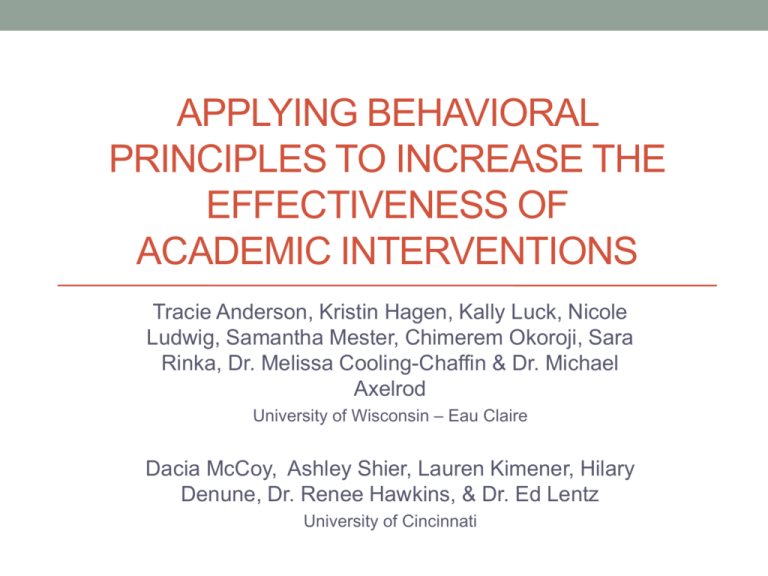
APPLYING BEHAVIORAL PRINCIPLES TO INCREASE THE EFFECTIVENESS OF ACADEMIC INTERVENTIONS Tracie Anderson, Kristin Hagen, Kally Luck, Nicole Ludwig, Samantha Mester, Chimerem Okoroji, Sara Rinka, Dr. Melissa Cooling-Chaffin & Dr. Michael Axelrod University of Wisconsin – Eau Claire Dacia McCoy, Ashley Shier, Lauren Kimener, Hilary Denune, Dr. Renee Hawkins, & Dr. Ed Lentz University of Cincinnati USING A BRIEF EXPERIMENTAL ANALYSIS TO EMPIRICALLY SELECT MATH COMPUTATION INTERVENTIONS Tracie Anderson, Kristin Hagen, Kally Luck, Nicole Ludwig, Samantha Mester, Chimerem Okoroji, Sara Rinka & Dr. Michael Axelrod University of Wisconsin – Eau Claire Introduction • Brief Experimental Analysis (BEA) is effective at empirically selecting oral reading fluency interventions (Burns and Wagner, 2008; Petursdottir, et al., 2009) • Time-efficient • Single subject design • Mong and Mong (2012) used BEA to empirically select effective interventions for math computation fluency • Taped Problems, Math to Mastery (Direct Instruction program) and Cover, Copy and Compare • Math to Mastery and Cover, Copy and Compare were found to be effective Brief Experimental Analysis • Cover, Copy, and Compare • Problem and answer on left column • Look at left column then cover problem • Copy problem from memory • Compare to original problem • Immediate Feedback with goal component • Interventionist completes worksheet with student help • Student completes worksheet with interventionist giving immediate feedback • Student completes timed worksheet to meet goal • Math Bingo (iPad application) • Play game for 10 minutes Method • Participants • 2 male 4th graders • Referred by teacher • Non-competing skill • Setting • Local elementary school • 2 small offices • Materials • Worksheets made from “Math Worksheet Generator” • Skill set assessment Skill Set Assessment Baseline • One minute test of math problems • JB: three digit plus two digit with carrying • BW: two digit plus two digit with carrying • Dependent Measures • Digits correct per minute (DCPM) • Errors per minute (EPM) • Time of intervention Intervention Selection • 3 rounds of BEA • Averaged each intervention to select treatment • Post test administered following each intervention • Procedural fidelity: 98% • Reliability of the dependent variables: 100% Results Results Discussion • Limitations • Only 2 days a week • Need more exposure to interventions, more opportunities to respond • Variations of completing problems • Using fingers or presumably calculating answer in head • Met maximum fluency for skill • Adjust target skill level • Contingent reinforcement Mong and Mong (2012) Reading Interventions Final Question • Can a BEA empirically select effective interventions for kids with math computation fluency deficits? • Maybe • Limited published research • We did not see meaningful change • Ours was not time efficient • High effort required by interventionist to select treatment • Potential to eliminate what was not effective • What do you do if you don’t empirically select interventions? What is the alternative? • Randomly pick one • Use best guess Future Research • Is a BEA more effective than randomly selecting an intervention? Parent selected or kid selected? Sources • Burns, M.K., & Wagner, D. (2008). Determining an effective intervention within a brief experimental analysis for reading: A meta-analytic review. School Psychology Review, 37, 126-136. • Mong, M.D., & Mong, K.W. (2012). The utility of brief experimental analysis and extended intervention analysis in selecting effective mathematics interventions. Journal of Behavioral Education, 21, 99-118. • Petursdottir, A. L., McMaster, K., McComas, J. J., Bradfield, T., Braganza, V., Koch-McDonald, J., … Schraf, H. (2009). Brief experimental analysis of early reading interventions. Journal of School Psychology, 47 (4), 215243. BEHAVIORAL INTERVENTIONS TARGETING MATH FACT FLUENCY Dacia McCoy, M.Ed. and Ashley Shier, M.Ed. University of Cincinnati Principles of Effective Interventions • Opportunities to Respond • Positive contingencies for accurate performance • Immediate feedback regarding performance accuracy • Instructional variables include: • Quick pacing • Error correction • Models, prompts, and fading of both (Lentz, Allen, & Ehrhardt ,1996) Introduction • Cases conducted by graduate students gaining field based experience • Utilizing Cover, Copy, and Compare and Flashcards to Increase Math Fact Fluency • Practicum experience in school aged academic interventions • Comparing Three Interventions to Improve the Multiplication Fact Fluency of Three High School Students with ED • First year research experience Practicum Case Methods • Participant • Adam (6th grade) • In the general education classroom • Diagnosed with ADHD and received special education services in the category of a Specific Learning Disability • Setting • Public middle school in a suburban school district Materials • Probes • AIMSweb Basic Addition and Subtraction- Intermediate Level • Flashcards • Addition or subtraction flash cards (Set of 10) • Timer (Set for 10 minutes) • CCC • CCC Form • Manila file folder/ strip of paper • Self- Graphing • Number of facts correct per session Cover, Copy, and Compare Form Write Fact Re-write Covered Fact Practice Fact Practice Fact If correct, go to the next fact If correct, go to the next fact If incorrect, practice 2 more times 1. 2. 3. 4. Accountability Design & Dependent Variable • AB single-case design • Visual analysis of weekly progress monitoring was used for databased decision making • Target Variables • Addition and Subtraction Fact Fluency- Digits Correct per Minute (DCPM) Decision Rules and Goals • Decision Rules • Three points below the aimline: The team would re-evaluate the intervention and necessary modifications • Three consecutive points at goal or above: Subtraction facts would be targeted • Goals • Peer comparison scores was used as a long term goal; however, the rate of improvement was used to set an attainable goal for the duration of the intervention (two months) Baseline Procedures • AIMSweb Probes • Two minute addition and subtraction probes • Median score of three probes • Peer Comparisons- one probe for three typical peers General Procedures • Three times per week • Flashcards- 10 minutes • CCC- 5-10 minutes • If the student gives the correct answer to the same fact on three occasions in less than 2 seconds to respond then the fact is considered known. • The same facts should be used for 3 sessions straight or until all 10 facts are considered “known” during the pre-assessment, whichever comes first. Then, 10 new “unknown” facts will be practiced. Flashcards Research supports flashcards as an effective intervention for math fact skills (Browder & Roberts, 1993; Cook & Guzaukas, 1993) Procedures: • Pre-Assessment and Self-graphing • Introduction (faded) • Flashcard procedure with immediate feedback • Post-Assessment and Self-graphing • Facts still remaining unknown will be practiced during CCC Student Self Graphing Cover, Copy, and Compare Research supports CCC as and effective intervention for students acquiring and becoming fluent in academic skills (Joseph et al., 2011). Procedures: • Target facts remaining “unknown” from the flashcard practice • Introduction (faded) • Student views the written math fact • Student covers the fact and writes the fact independently in the next column (stating quietly) • Student checks answer • • • If correct, student continues to next fact If incorrect, student practices the fact two more times (three times total) Repeat with all remaining facts. Results Results • Adherence • Inter-scorer Agreement • Social Validity • Student: Ratings suggested that he strongly agreed that the intervention was helpful, easy to use, and helped him improve with math facts • Teachers: Both teachers responded with positive ratings of agree and strongly agree, suggesting that the intervention was perceived favorable and effective Research Methods • Participants • Jess and Doug (9th grade), Casey (10th grade) • All met criteria for Emotional Disturbance (ED) • Baseline data indicated none met multiplication fact fluency criteria (i.e., 40 DCM, ; Shapiro, 2004) • Setting • Alternative school for students with challenging behaviors Materials • Probes • 1x1 digit multiplication facts using the numbers 2-9 • 3 mutually exclusive problem sets • 3 alternate forms (A,B,C) of the probe were created • 48 problems per probe • 1 minute • Binders • Individual binders with scripts and probes • 1 VSM video on a CD • MP3 player for taped problems • Flashcards Research Design & Dependent Variables • Alternating Treatment Design • Target Variable: Digits Correct per Minute (DCM) General Procedures • Intervention was conducted 3 times a week with a different intervention each session • Interventions were followed by assessment probes that coordinated with the intervention Taped Problems • Research supports taped problems as effective for increasing fact fluency (McCallum et al., 2010; Bliss et al., 2010) • Students were instructed to listen to the tape, complete the worksheet and and let the teacher know when they were done • Mp3 player included instructions and each multiplication fact followed by a pause (repeated 4 times each). Video Self Modeling • VSM has been supported as effective for ameliorating a number of different social and functional skills (MacDonald et al., 2005; Haring et al., 1987; Alcantara, 1994) • One study to date has found VSM effective at increasing fraction skills • A video was created of the student fluently responding to the math facts • Students were told to watch the video and let the teacher know when they were done. Flashcards • Research has supporting flashcards as an effective intervention for math fact skills (Browder & Roberts, 1993; Cook & Guzaukas, 1993) • No studies to date have compared traditional flashcard drill to other interventions • Flashcards were presented one at a time with feedback given after the response • The entire fact set was administered 4 times Interscorer Agreement & Adherence • ISA 25% of sessions • 100% agreement for DCM • Adherence: 20.62% of sessions • 97.22% average adherence (range, 88.89-100%) Baseline Performances Results Casey 70 Alternating Treatments Extended Phase- TP Digits Correct Per Minute 60 TP 50 40 FC 30 VSM 20 10 0 1 2 3 4 5 6 7 8 9 10 11 12 13 14 15 16 17 18 19 20 21 22 23 24 25 26 27 28 29 30 31 32 33 34 35 36 37 38 39 40 41 42 43 Sessions TP PS1 FC PS3 VSM PS2 PS3 PS2 Jess Extended Phase- FC 70 Alternating Treatments 60 Digits Correct Per Minute 50 FC 40 VSM 30 TP 20 10 0 1 2 3 4 5 6 7 8 9 10 11 12 13 14 15 16 17 18 19 20 21 22 23 24 25 26 27 28 29 30 31 32 33 34 35 36 37 38 39 40 41 42 43 Sessions VSM PS1 FC PS2 TP PS3 PS1 PS2 PS3 Doug Alternating Treatments 70 Digits Correct Per Minute 60 50 40 FC 30 TP 20 10 VSM 0 1 2 3 5 6 7 8 9 10 11 12 13 14 15 16 17 18 19 20 21 22 23 24 25 26 27 28 29 30 31 32 33 34 35 36 37 38 39 40 41 42 43 Sessions FC PS1 TP PS2 VSM PS3 Intervention Statistics Casey Jess Doug Discussion • VSM not effective for any participant • Active vs. Passive engagement? • Idiosyncrasy of Intervention success • Implementation with little practitioner support • Modifying instructional material to match students’ instructional level • Generalization from addition to subtraction • Additional Behavioral Principles and Strategies Addressed • Response signals • Standardized method of error correction • Student self-graphing Limitations • Multiple absences • Late start to intervention • End of the year interruptions • Limited amount of time weekly to implement • Timing of progress monitoring data collection References Alcantara, P. R. (1994). Effects of videotape instructional package on purchasing skills of children with autism. Exceptional Children, 61(1), 40-55. Bliss, S. L., Skinner, C. H., McCallum, E., Saecker, L. B., Rowland-Bryant, E., & Brown, K. S. (2010). A comparison of taped problem with and without a brief post-treatment assessment on multiplication fluency. Journal of Behavioral Education, 19, 156-168. Browder, D.M. & Roberts, M.L. (1993). Guidelines for flash card instruction. Journal of Behavioral Education, 3, 235-245. Cooke, N.L. & Guzaukas, R. (1993). Effects of using a ratio of new items to review items during drill and practice: Three experiments. Education and Treatment of Children, 16, 213-235. Haring, T.G., Kennedy, C.H., Adams, M.J., & Pitts-Conway, V. (1987). Teaching generalization of purchasing skills across community settings to autistic youth using videodisc modeling. Journal of Applied Behavior Analysis, 20, 89-96 . Joseph, L. M., Konrad, M., Cates, G., Vajcner, T., Eveleigh, E., & Fishley, K. M. (2011). A metaanalytic review of the cover-copy-compare and variations of this self-management procedure. Psychology is the Schools, 49(2), 122-136. doi:10.1002/pits McCallum, E., Skinner, C. H.,& Hutchins,H. (2004). The taped-problems intervention: Increasing division fact fluency using a low-tech self-managed time-delay intervention. Journal of Applied School Psychology, 20, 129-147. APPLYING BEHAVIORAL PRINCIPLES IN AN EARLY LITERACY TUTORING PROGRAM Lauren Kimener, M.Ed. and Hilary Denune, M.Ed. University of Cincinnati Introduction • This case study demonstrates: • The implementation of evidence-based early literacy interventions based on behavioral principles for students from at-risk populations • The use of decision rules and data-based decision making when evaluating the effectiveness of academic interventions • Providing performance feedback to support skill development in school psychology trainees University of Cincinnati Tutoring Program • As part of their required coursework, 1st year school psychology trainees complete externship experiences leading small group literacy interventions for elementary and middle school students in literacy skills • Externship experiences provide first year school psychology trainees with experience in: • Universal screening and progress monitoring using DIBELS Next assessments • Data based decision making and visual analysis • Implementing an evidence based, direct instruction intervention for Tier 2 small groups • Home-school collaboration University of Cincinnati Tutoring Program • Tutors are trained in one of two evidence-based, small group literacy interventions based on the principles of direct instruction • Kindergarten Peer-Assisted Literacy Strategies (K-PALS) • Designed for students in kindergarten and 1st grade • Two types of activities in each lesson: Sound play and decoding • Corrective Reading • Designed for students from 4th grade on demonstrating literacy skills below grade level • Addresses deficiencies in decoding and comprehension University of Cincinnati Tutoring Program • Intervention intensity was based on the needs of individual students • All additional intervention components developed based on recommendations from the Florida Center for Reading Research • Letter arc • Alphabet borders • Say it and Move it Behavioral Strategies demonstrated through Intervention Procedures • Intervention procedures implemented by tutors demonstrate the application of strategies based on behavioral principles • Scripted intervention procedures • Structure of lessons can be used to develop procedural checklists to be used during adherence checks • Response signals and choral responding • Interventions provided for increased practice opportunities in school and at home • Increased number of opportunities to demonstrate target skills, receive corrective feedback, and come into contact with reinforcement for the appropriate demonstration of target skills • Standardized method of error correction • Repetition, corrective feedback • Intervention procedures provide for positive contingencies • Praise • Groups have the opportunity to earn points Methods • Participants and Setting: • 62 Kindergarten students at two primary schools within the same suburban school district, from 12 different classes • Intervention sessions were conducted in groups of 3-4 students with 1 tutor, outside of classroom • 6 UC School Psychology first year students served as tutors • Building School Psychologists and 2nd year doctoral student served as supervisors • 6 Kindergarten teachers participated in monthly team meetings evaluating student progress • Parents received monthly progress reports and activities to increase practice opportunities at home Methods Target Variables & Measurement • For Kindergarten Students: • Phonological Awareness & Alphabetic Principle/Basic Phonics • Kindergarten DIBELS Next measures: First Sound Fluency (FSF), Phoneme Segmentation Fluency (PSF), and Nonsense Word Fluency (NWF) • For 1st Year Trainees: • Fluency & Adherence of Intervention Implementation • Direct observation using procedural checklists of intervention components and using momentary time sampling of tutoring contacts for on-task/off-task behavior • Reliability of Measurement • Inter-rater reliability of DIBELS Next administration • Use of data to make decisions regarding intervention effectiveness • Direct observation of team meetings & permanent product review (graphs) Methods Goal-setting • Progress toward end-of-year benchmark was monitored weekly for Kindergarten students • FSF: 30 Correct Sounds per Minute (by Winter benchmark period) • PSF: 41 Correct Sounds per Minute • NWF: 28 Correct Letter Sounds per Minute • Fluency in implementation of intervention procedures was assessed throughout the year and performance feedback was provided to tutors Decision Rules: • Students must meet or exceed end-of-year benchmark 3 times on each measure • If student falls below aim-line for 3 consecutive data points, more intensive intervention is needed • Tutors must show progress toward criterion before decreased frequency of technical checks and performance feedback Methods Procedures • First-year school psychology students were trained as tutors by 2nd year supervisor • Trained to criterion in DIBELS Next administration, intervention and behavior plan implementation, graphing and visual analysis • Tutors implemented early literacy interventions in small groups for 20 minutes per session, 3 times a week for 29 weeks • Tutors also designed and implemented behavior plans in groups (e.g., group contingencies, token economies) Methods Procedures (cont’d) • Students were assessed weekly in DIBELS Next measures • Technical checks and performance feedback sessions were conducted by 2nd year supervisor and peer tutors on a decreasing intensity schedule (e.g., weekly, bi-monthly, monthly) • Teachers, tutors and supervisors met monthly to evaluate student progress and the effects of intervention, and to engage in data-based decision-making and problem solving Accountability Design • AB single-case designs were used to evaluate the effects of early literacy interventions on student FSF, PSF, and NWF scores • Through visual analysis of student graphs, data-based decisions were made regarding student and trainee outcomes Results Student Outcomes – Year 1 • 46% of the students in the program met end-of-year benchmarks • 74% of the students in the program moved up in a risk indicator category Actual ROI Met Benchmark Moved up in Risk Category 1.63 2.31 92% 88% PSF 0.77 1.54 76% 84% NWF-CLS 0.39 0.78 64% 84% DIBELS Measure Needed ROI FSF Results Student Outcomes – Year 2 *Group data Actual ROI Met Benchmark Moved up in Risk Category 1.27 5.40 85.7% 93% PSF 2.00 2.83 77% 91% NWF-CLS 1.62 2.79 79% 95% DIBELS Measure Needed ROI FSF Results Results Results Results Trainee Outcomes – Year 1 Results Trainee Outcomes – Year 2 Discussion • The implementation of evidence-based early literacy interventions based on behavioral principles to address early literacy skills in students from at-risk populations • The use of decision rules and data-based decision making when evaluating the effectiveness of academic interventions • Providing performance feedback to support skill development in school psychology trainees Discussion • The implementation of evidence-based early literacy interventions based on behavioral principles to address early literacy skills in students from at-risk populations • Overall positive effect for students who were at-risk; effective in catching students up to benchmark performance levels • High rates of improvement & percentage of students moved up in risk category indicators Discussion • The use of decision rules and data-based decision making when evaluating the effectiveness of academic interventions • Delivery of tiered services; increased or decreased intensity of intervention based on progress monitoring data • Application of behavioral principles to academic intervention Discussion • Providing performance feedback to support skill development in school psychology trainees • Trainees demonstrated high levels of intervention adherence and data reliability independently and with accuracy • Self-conducted technical checks allowed trainees to evaluate peer performance Thank you!

